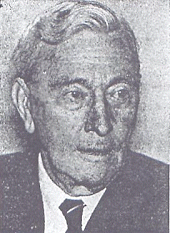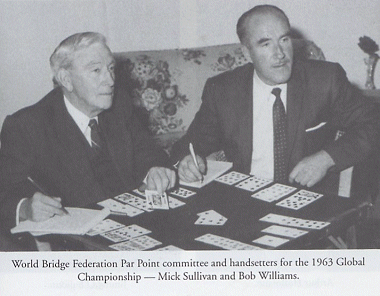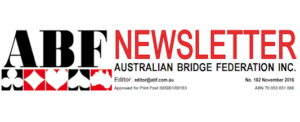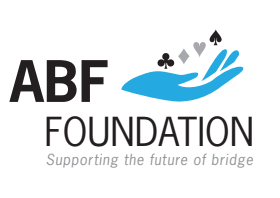The fact that today we take international bridge competition for granted is a tribute to MJ (Mick) Sullivan. As Colin Masters said in his biography, ‘few if any Australians have championed the cause of Australian bridge on the world scene’. He was also a great player over several decades, one of the pioneer promoters of contract bridge and one of the best ever analysts of a hand.
He was born in 1894 at the family homestead in Beaudesert, Queensland. He graduated dux of his school and wanted to study law but family finances (his father had died when he was ten) forced him to return home and work on the family property.
In 1922 he gave up the property and moved to Southport and started a hardware shop with his brother. The 1920s were good times. He married; the store went well; his sporting ability made him a well-known local figure; and at 29 he was President of the local Chamber of Commerce.
All this changed very quickly. His wife died in 1930 leaving him with four young children. The store closed a year later – a victim of the Great Depression. Leaving his four children temporarily in the care of relatives, he went to Brisbane to find work.
His involvement with bridge began in a small way with a casual job at a Brisbane bridge club but he quickly took on a prominent role. He conceived and was secretary of the first Queensland Auction Bridge Championship in 1932 – comprising a mixed and men’s event run on rubber bridge lines with cumulative scoring. He wrote articles for the Courier Mail and regional papers and also made radio broadcasts about the game. In 1932 he and Will Boyce opened the Brisbane Bridge Club which quickly became the main focal point for bridge in Queensland.
He was quick to see the advantage of Contract over Auction. He was a regular correspondent with Culbertson and heavily and effectively promoted the spread of the new game.
In the ensuing years Mick made major impacts on bridge as an administrator, player, writer and analyst, and finally as a developer of bridge as a true world game.
During the 1930s he built an international reputation as a bridge writer through his contributions to Bridge World (US) and The Bridge Magazine (UK). He was regarded as one of the very best analysts and setters of double dummy puzzles. One of his classics in which declarer sets up a double squeeze without rectifying the count is included in Colin Master’s book.
He was Tournament Director of the QBA from 1938 to 1952; Secretary from 1939 to 1945; and President in 1950 and 1951. He was Secretary of the Australian Council of Bridge from 1939 and held a number of other honorary positions in the organisation.
As a player, he was a member of the winning team in the 1937 and 1939 Australia and New Zealand Olympiads. He was also a member of the winning team in the Australian section of the World Olympic contests in 1939, 1940 and 1941. With Harold Hiley, he won the Australia par point open pairs championship in 1942, 1950 and 1956. In 1950 the partnership achieved an astonishing 98 per cent. He was a member of all Queensland teams between 1946 and 1957.
After the war he began a long campaign to get international competition for Australian players and recognition of the quality of Australian bridge. In April 1950 he reported on the interstate competition for the American Bridge World and in a famous statement quoted by Cathy Chua noted that:
“The opinion is widely held here that a representative Australian team might easily prove itself to be more than a match for the best American quartet. And incidentally, an equally impressive Australian women’s team could be fielded.”
He followed this with a challenge to Bridge World to encourage a visit to Australia by an American team.
For competition, in 1951, the Jubilee year, he suggested and organised the World Olympic Bridge Competition (and set the hands with Harold Hiley). The Australian government agreed to recognise it as an official Jubilee event – making it possibly the first time that a national government sponsored a bridge event. He was a major source of the pressure that eventually broke down the resistance in Australia to moving from total scores (like rubber bridge) to IMPS.
From this point Mick upped his attacks on the current state of world bridge. In an article in European Bridge Review on the 1950 Bermuda Bowl, which was open to just two countries he led in with the title of ‘Palookas! – And their World Championship’.
After good performances by Australians in the 1953 Anglo-American bidding match, he returned to his theme in European Bridge Review stating that this was support for his “tall claim” that “the best Australian combination would be capable of defeating any other bridge team in the world”.
In 1954 he organised the World Bidding Challenge. In 1955 he put in a lot of effort to get an English team to Australia for an event that would coincide with the Olympic Games but this eventually fell through because of lack of funds. He also secured an invitation for a New Zealand team to compete in the interstate (in the hope that this would encourage Australian teams to go to New Zealand), but nothing came of this at the time.
In 1958 he was a member of the first Australian touring team (with Bill Schaufelberger, Tim Seres and Dick Cummings). In his reports back home Mick focussed on the “consistently brilliant performances” by the Seres-Cummings partnership but the whole team did well. The team played in eleven tournaments for three wins and four seconds – making a very positive impact on the image of Australian bridge.
Because of health issues, this tour marked the end of Mick’s competitive playing career but it also marked the coming to fruition of many years of working to create regular opportunities for Australians to compete overseas and an effective infrastructure for international bridge.
Other things though fell into place. Several leading figures in the game including Sullivan had been corresponding about a world bridge body. A conference was held in 1958 to coincide with the annual Juan-les-Pins congress to discuss new approaches to the organisation of international bridge. Sullivan was the representative of the Australian Bridge Council.
The group, consisting of Sullivan, Baron Robert de Nexon (France), Charles Goren (US) and Geoffrey Butler (England), proposed a World Bridge Federation managed by an executive representing the different zones. The proposal was ratified in Oslo and Mick Sullivan became a founding member of the Executive as representative of Zone 7 – a position he held until his retirement in 1970. He reported to the Australian Bridge Council that:
“For many years past I have been agitating for formation of a global governing body and, at Oslo last August was naturally most gratified to find myself playing a part, as your official representative, in founding the WBF. A great compliment was paid to Australian bridge and to myself when I was appointed to membership of its eight-man Inaugural Council. I strongly recommend the ABC to affiliate immediately with this new global organisation and to co-operate with the NZCBL and myself in the formation of its Australia-New Zealand zone .”
As Chair of the Constitution Committee, he was responsible for helping many national associations develop their constitutions. He was a driving force behind the revised laws issued in 1963.
In 1961 and 1963, with Sydney player Bob Williams (and Dennis Priest in 1963) he ran the World Par Point Olympiads, reinforcing his reputation as one of the best, and probably the best ever setters of par hands.
Often a problem in these contests was that many expert pairs would get 100%. This did not happen with Sullivan hands. Although such events are no longer common, his and Bob Williams’ legacy lives on in the laws of par point events that they drafted in 1963 and are still in force.
Mick retired in 1970 and was made a life member of the ABF in 1974 shortly before his death on 29 December 1974. He is the first person on the ABF’s Roll of Honour.
Sources:
| ___________ | “Mick Sullivan retires” Australian Bridge (April 1970) p2 |
| Cathy Chua | The History of Australian Bridge |
| Cathy Chua | “Michael J Sullivan 1894-1974” Australian Bridge Federation Newsletter |
| Colin Masters | Mind Games |













